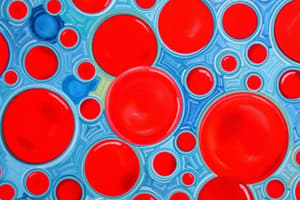Podcast
Questions and Answers
What is the primary component of plasma in blood?
What is the primary component of plasma in blood?
- Glucose
- Fibrinogen
- Water (correct)
- Platelets
Which blood component is primarily responsible for regulating body temperature?
Which blood component is primarily responsible for regulating body temperature?
- Plasma (correct)
- White Blood Cells
- Platelets
- Red Blood Cells
Which of the following proteins makes up the greatest percentage of plasma proteins?
Which of the following proteins makes up the greatest percentage of plasma proteins?
- Prothrombin
- Albumin (correct)
- Globulin
- Fibrinogen
What is the normal hematocrit value for an adult female?
What is the normal hematocrit value for an adult female?
Which function of blood is involved in transporting carbon dioxide?
Which function of blood is involved in transporting carbon dioxide?
What percentage of blood volume do red blood cells constitute in a normal adult male?
What percentage of blood volume do red blood cells constitute in a normal adult male?
Which substance in the blood is primarily responsible for preventing blood loss?
Which substance in the blood is primarily responsible for preventing blood loss?
What is the main role of red blood cells in the blood?
What is the main role of red blood cells in the blood?
What is the osmotic pressure of plasma proteins?
What is the osmotic pressure of plasma proteins?
Which cell type is primarily involved in protecting the body against infections?
Which cell type is primarily involved in protecting the body against infections?
Flashcards
Blood Composition
Blood Composition
Blood is composed of plasma (liquid portion) and cellular components (red blood cells, white blood cells, platelets).
Plasma Composition
Plasma Composition
Plasma, the liquid part of blood, is mostly water (90%) and contains dissolved substances like proteins, nutrients, waste products, and electrolytes.
Cellular Components of Blood
Cellular Components of Blood
These are the cells within blood: Red Blood Cells (RBCs), White Blood Cells (WBCs), and Platelets.
Red Blood Cells (RBCs)
Red Blood Cells (RBCs)
Signup and view all the flashcards
White Blood Cells (WBCs)
White Blood Cells (WBCs)
Signup and view all the flashcards
Platelets
Platelets
Signup and view all the flashcards
Haematocrit Value (HV)
Haematocrit Value (HV)
Signup and view all the flashcards
Plasma Functions
Plasma Functions
Signup and view all the flashcards
Blood Clotting
Blood Clotting
Signup and view all the flashcards
Blood Transport
Blood Transport
Signup and view all the flashcards
Study Notes
Blood Composition and Functions
- Blood is composed of 55% plasma and 45% formed elements.
- Plasma is 90% water, 0.9% inorganic salts (NaCl, HCO3), and 7.1 gm% plasma proteins (albumin, globulin, fibrinogen, prothrombin), plus organic substances and waste products, hormones, enzymes, and vitamins (2%).
- Formed elements include red blood cells (45%), white blood cells (<1%), and platelets (<1%).
Red Blood Cells (RBCs)
- Structure: Flat, biconcave disc, non-nucleated, made of a protein framework, contains hemoglobin, diameter 7.2μm, thickness 2.2μm, and volume 90 femtoliters (FL).
- Function: Carry hemoglobin, transport oxygen and carbon dioxide, and regulate pH. Metabolically active cells use glucose for energy.
- Count: Males 4.8-5.8 million cells/mm3, Females 4.2-5.2 million cells/mm3.
- Life span: 120 days (4 months).
Erythropoiesis (RBC Formation)
- Stages: Stem cell → Proerthroblast → Early, Intermediate, Late Normoblast → Reticulocytes → Erythrocytes.
- Rapid RBC production increases reticulocytes in circulation.
- Site of formation:
- Fetus: Liver and spleen
- Baby: Bone marrow of all bones
- Adult: Bone marrow of flat bones (skull, iliac bones, sternum, ribs, scapula).
- Extramedullary erythropoiesis: Return of liver and spleen to form blood cells when needed.
Factors Affecting Erythropoiesis
- Control of erythropoiesis: Erythropoietin
- Substances essential to erythropoiesis:
- Proteins and amino acids: Important for globin synthesis
- Iron: Essential for hemoglobin synthesis
- Folic acid and Vitamin B12: Needed for DNA synthesis
- Trace elements (copper, cobalt): Cofactors for hemoglobin formation
- Hormones (androgens, thyroxine, glucocorticoids): Stimulate erythropoiesis, Estrogen inhibits it
- Healthy bone marrow and liver: Essential for processes
Plasma Proteins
- Types: Albumin (4.8 g/100 ml), globulin (2.3 g/100 ml), fibrinogen (0.3 g/100 ml) (Total: 7.4 g/100 ml)
- Structures: Specific molecular weights and functions.
- Synthesized in the liver.
- Functions: Transportation, maintenance of fluid balance, osmotic pressure, viscosity, clotting, defense mechanisms (antibodies), and acting as a holding place for certain hormones.
Iron Absorption
- Amount absorbed: 15-20 mg/day
- Iron losses: 0.6-1.0 mg/day in males; varies in females, potentially up to 2 mg/day for menstruating females
- Iron is more readily absorbed in the ferrous state (Fe++).
- Factors that help iron absorption: Vitamin C
- Factors that decrease iron absorption: Phytic acid, oxalates, phosphates which cause insoluble iron salts
- Apoferritin: Protein in mucosal cells that binds to iron.
- Ferritin: Complex of apoferritin and Fe++
- Storage iron: Iron in ferritin is an iron storage form
- Transferrin: Plasma protein that transports iron
- Sources: Diet, heme iron, non-heme iron
Folic Acid and Vitamin B12
- Folic acid functions: Synthesis of pyrimidines and thymine, essential for DNA and cell division, erythrocyte division, important for RNA to DNA transformation
- Vitamin B12 functions: Required for folic acid action, required for myelin formation, dependent on dietary intake (animal products), needs intrinsic factor for absorption. Vitamin deficiencies can lead to neurological issues and megaloblastic anemia (a type of blood disorder).
Additional Notes on blood
- 3500ml Plasma in 70kg man, 5% of body weight
- pH:7.4
- Osmotic pressure: 290 mOsmol
- Plasma protein osmolarity=5000 mmHg
Studying That Suits You
Use AI to generate personalized quizzes and flashcards to suit your learning preferences.




